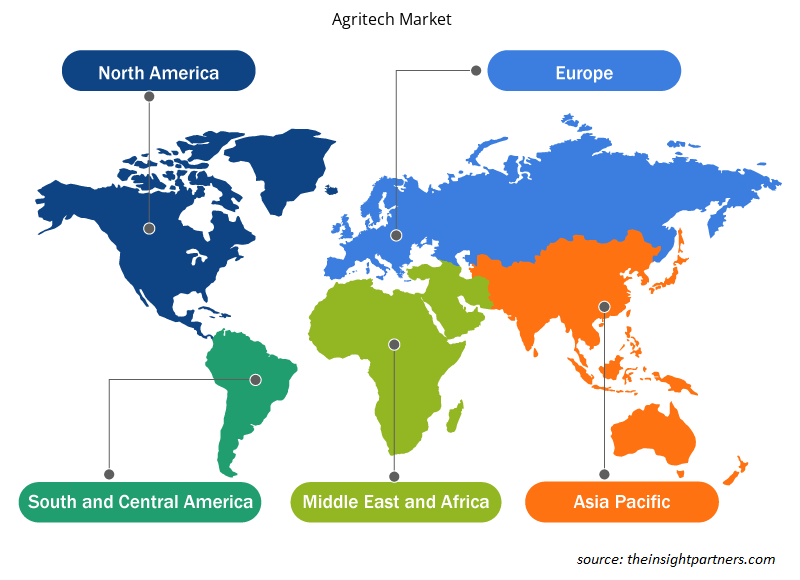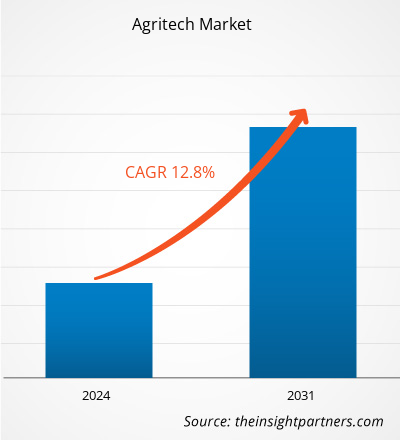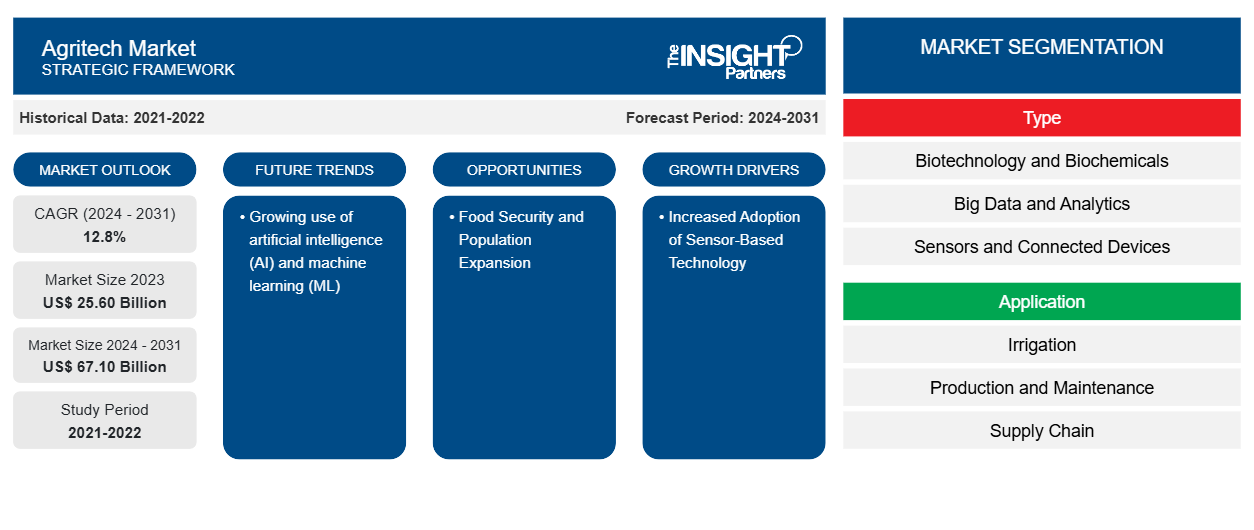Der globale Agrartechnologiemarkt soll von 25,60 Milliarden US-Dollar im Jahr 2023 auf 67,10 Milliarden US-Dollar im Jahr 2031 wachsen; von 2024 bis 2031 wird eine durchschnittliche jährliche Wachstumsrate von 12,8 % erwartet. Der zunehmende Einsatz künstlicher Intelligenz (KI) und maschinellen Lernens (ML) dürfte ein wichtiger Trend auf dem Agrartechnologiemarkt bleiben.
Agritech-Marktanalyse
Die Einführung sensorgestützter Agrartechnologie ist neben der wachsenden Zahl von Agritech-Startups ein wichtiger Wachstumsfaktor auf dem Agritech-Markt.
Agritech-Marktübersicht
Agritech oder Agrartechnologie bezeichnet die Anwendung technischer Durchbrüche in der Landwirtschaft zur Verbesserung von Produktivität, Effizienz und Rentabilität. Dabei geht es um den Einsatz von Technologie zur Beschleunigung des Anbaus, zur Entwicklung von Nutzpflanzen, die in unterschiedlichen Umgebungen gedeihen, und zur Ernte . Es kann sich auch auf die Nutzung von Robotik, Big Data, künstlicher Intelligenz oder anderen Mitteln beziehen, die zur Lösung der Probleme, mit denen die Agrarwirtschaft konfrontiert ist, unerlässlich sind. Darüber hinaus wird Agritech genutzt, um hochmoderne, auf dem Internet der Dinge basierende Software zu entwickeln, die genaue Informationen über das Wetter, die Bodenqualität und den aktuellen Zustand verfolgen und liefern kann. IoT-Technologien werden in der Landwirtschaft eingesetzt, um die Landwirtschaft zu optimieren, ohne die Ressourcen oder Zeit der Landwirte zu erschöpfen, indem sie ihnen Echtzeitinformationen über ihre Nutzpflanzen und Betriebe liefern.
Passen Sie diesen Bericht Ihren Anforderungen an
Sie erhalten kostenlos individuelle Anpassungen an jedem Bericht, einschließlich Teilen dieses Berichts oder einer Analyse auf Länderebene, eines Excel-Datenpakets sowie tolle Angebote und Rabatte für Start-ups und Universitäten.
-
Holen Sie sich die wichtigsten Markttrends aus diesem Bericht.Dieses KOSTENLOSE Beispiel umfasst eine Datenanalyse von Markttrends bis hin zu Schätzungen und Prognosen.
Treiber und Chancen auf dem Agritech-Markt
Verstärkter Einsatz sensorbasierter Technologie begünstigt Markt
Der zunehmende Einsatz sensorbasierter Technologien treibt die Technologieausgaben in der Agrartechnologiebranche an. Dabei werden Sensorgeräte und IoT-Technologien eingesetzt . Diese Technologien ermöglichen es Landwirten, Daten zu einer Vielzahl von Parametern zu sammeln, darunter Wettermuster, Bodenbedingungen und Ernteerträge, sodass sie fundiertere Entscheidungen treffen können. Auf den Feldern installierte Sensoren liefern Landwirten Echtzeitinformationen zu Bodenfeuchtigkeit, Temperatur und Säuregehalt. Diese Informationen ermöglichen es den Landwirten, umgehend Entscheidungen über Bewässerung, Stickstoffzufuhr und Pflanzenschutz zu treffen.
Ernährungssicherheit und Bevölkerungswachstum
Das Bevölkerungswachstum setzt die weltweite Nahrungsmittelversorgung unter Druck. Agritech versucht, den Nährstoffbedarf der wachsenden Bevölkerung zu decken. Technologien wie Drohnen und GPS-gesteuerte Traktoren ermöglichen präzises Pflanzen und Ernten, was die Betriebsmittelkosten und die Umweltbelastung senkt. Darüber hinaus bieten datengesteuerte Lösungen den Landwirten wertvolle Einblicke in Wettermuster, Bodenbedingungen und Ernteerträge, sodass sie fundierte Entscheidungen treffen können.Agritech attempts to meet the nutritional needs of the rising population. Precision planting and harvesting are enabled by technologies such as drones and GPS-guided tractors, which reduce input costs and environmental effect. Furthermore, data-driven solutions give farmers with valuable insights into weather patterns, soil conditions, and crop performance, allowing them to make educated decisions.
Segmentierungsanalyse des Agritech-Marktberichts Market Report Segmentation Analysis
Schlüsselsegmente, die zur Ableitung der Agritech-Marktanalyse market beigetragen haben , sind Typ und Anwendung.
- Nach Typ ist der Markt in Biotechnologie und Biochemie, Big Data und Analytik, Sensoren und verbundene Geräte, Mobilität und Sonstiges unterteilt. Das Segment Biotechnologie und Biochemie hatte im Jahr 2023 einen größeren Marktanteil.
- In Bezug auf die Anwendung ist der Markt in Bewässerung, Produktion und Wartung, Lieferkette und Marktplatz unterteilt. Das Produktions- und Wartungssegment hatte im Jahr 2023 einen größeren Marktanteil.
Agritech-Marktanteilsanalyse nach Geografie Market Share Analysis by Geography
Der geografische Umfang des Agritech-Marktberichts ist hauptsächlich in fünf Regionen unterteilt: Nordamerika, Asien-Pazifik, Europa, Naher Osten und Afrika sowie Südamerika/Süd- und Mittelamerika. Nordamerika dominierte den Agritech-Markt im Jahr 2023. Das Wachstum des regionalen Marktes ist auf die zunehmende Einführung der Präzisionslandwirtschaft zurückzuführen. Präzisionslandwirtschaftstechnologie wie Drohnen, sensorbasierte Systeme und GPS-gesteuerte Traktoren ist in Nordamerika weit verbreitet. Diese Technologie ermöglicht es Landwirten, die Ernteerträge zu maximieren, die Inputkosten zu senken und die Gesamtproduktivität des Betriebs zu verbessern. Präzisionslandwirtschaftstechnologien, darunter Drohnen, sensorbasierte Systeme und GPS-gesteuerte Traktoren, haben die Landwirtschaft revolutioniert. Durch den Einsatz dieser Technologien können Landwirte eine höhere Effizienz und Produktivität in ihren Betrieben erreichen.
Regionale Einblicke in den Agritech-Markt
Die regionalen Trends und Faktoren, die den Agritech-Markt im Prognosezeitraum beeinflussen, wurden von den Analysten von Insight Partners ausführlich erläutert. In diesem Abschnitt werden auch die Marktsegmente und die Geografie des Agritech-Marktes in Nordamerika, Europa, im asiatisch-pazifischen Raum, im Nahen Osten und Afrika sowie in Süd- und Mittelamerika erörtert.

- Erhalten Sie regionale Daten zum Agritech-Markt
Umfang des Agritech-Marktberichts
| Berichtsattribut | Details |
|---|---|
| Marktgröße im Jahr 2023 | 25,60 Milliarden US-Dollar |
| Marktgröße bis 2031 | 67,10 Milliarden US-Dollar |
| Globale CAGR (2024 - 2031) | 12,8 % |
| Historische Daten | 2021-2022 |
| Prognosezeitraum | 2024–2031 |
| Abgedeckte Segmente |
Nach Typ
|
| Abgedeckte Regionen und Länder |
Nordamerika
|
| Marktführer und wichtige Unternehmensprofile |
|
Marktteilnehmerdichte: Der Einfluss auf die Geschäftsdynamik
Der Agritech-Markt wächst rasant, angetrieben durch die steigende Nachfrage der Endverbraucher aufgrund von Faktoren wie sich entwickelnden Verbraucherpräferenzen, technologischen Fortschritten und einem größeren Bewusstsein für die Vorteile des Produkts. Mit steigender Nachfrage erweitern Unternehmen ihr Angebot, entwickeln Innovationen, um die Bedürfnisse der Verbraucher zu erfüllen, und nutzen neue Trends, was das Marktwachstum weiter ankurbelt.
Die Marktteilnehmerdichte bezieht sich auf die Verteilung der Firmen oder Unternehmen, die in einem bestimmten Markt oder einer bestimmten Branche tätig sind. Sie gibt an, wie viele Wettbewerber (Marktteilnehmer) in einem bestimmten Marktraum im Verhältnis zu seiner Größe oder seinem gesamten Marktwert präsent sind.
Die wichtigsten auf dem Agritech-Markt tätigen Unternehmen sind:
- ARSR-Technik
- AeroFarms
- Apollo Landwirtschaft
- Crofarm Agriproducts Pvt Ltd
- Conservis
- Indigo Ag, Inc.
Haftungsausschluss : Die oben aufgeführten Unternehmen sind nicht in einer bestimmten Reihenfolge aufgeführt.

- Überblick über die wichtigsten Akteure auf dem Agritech-Markt
Neuigkeiten und aktuelle Entwicklungen vom Agritech-Markt
Der Agritech-Markt wird durch die Erhebung qualitativer und quantitativer Daten nach Primär- und Sekundärforschung bewertet, die wichtige Unternehmensveröffentlichungen, Verbandsdaten und Datenbanken einbezieht. Im Folgenden finden Sie eine Liste der Entwicklungen auf dem Markt:
- Im Januar 2024 sicherte sich Apollo Agriculture, eine kommerzielle Landwirtschaftsplattform, die Kleinbauern bei der Maximierung ihrer Gewinne unterstützt, 10 Millionen US-Dollar an Finanzmitteln, um sein weiteres Wachstum zu unterstützen. Das 2019 gegründete kenianische Startup bietet Landwirten Zugang zu Finanzierungen, hochwertigen landwirtschaftlichen Betriebsmitteln, Versicherungen und optimierter Beratung, um ihre Rentabilität zu steigern. Die jüngste Finanzierung wird es Apollo Agriculture ermöglichen, seine Geschäftstätigkeit in Kenia auszuweiten und mehr Landwirten zu helfen, erfolgreich zu sein, sich an den Klimawandel anzupassen und zur Ernährungssicherheit beizutragen.
(Quelle: Apollo Agriculture, Pressemitteilung, 2024)
- Im Februar 2023 stellte AeroFarms, eine zertifizierte B Corporation und weltweit führender Anbieter von vertikaler Indoor-Landwirtschaft, AeroFarms AgX vor, seine neueste hochmoderne vertikale Indoor-Farm. Diese hochmoderne Einrichtung konzentriert sich auf innovative Forschung und Entwicklung (F&E) und befindet sich in den VAE, genauer gesagt in Abu Dhabi. AeroFarms AgX zielt darauf ab, eine nachhaltige Landwirtschaft in kontrollierter Umgebung (CEA) und vertikale Indoor-Landwirtschaft voranzutreiben, um umfassendere globale Herausforderungen in der landwirtschaftlichen Lieferkette zu bewältigen.
(Quelle: AeroFarms, Pressemitteilung, 2023)
Abdeckung und Ergebnisse des Agritech-Marktberichts
Der Bericht „Agritech-Marktgröße und -prognose (2021–2031)“ bietet eine detaillierte Analyse des Marktes, die die folgenden Bereiche abdeckt:
- Marktgröße und Prognose auf globaler, regionaler und Länderebene für alle wichtigen Marktsegmente, die im Rahmen des Projekts abgedeckt sind
- Marktdynamik wie Treiber, Beschränkungen und wichtige Chancen
- Wichtige Zukunftstrends
- Detaillierte PEST/Porters Five Forces- und SWOT-Analyse
- Globale und regionale Marktanalyse mit wichtigen Markttrends, wichtigen Akteuren, Vorschriften und aktuellen Marktentwicklungen
- Branchenlandschaft und Wettbewerbsanalyse, einschließlich Marktkonzentration, Heatmap-Analyse, prominenten Akteuren und aktuellen Entwicklungen
- Detaillierte Firmenprofile
- Historische Analyse (2 Jahre), Basisjahr, Prognose (7 Jahre) mit CAGR
- PEST- und SWOT-Analyse
- Marktgröße Wert/Volumen – Global, Regional, Land
- Branchen- und Wettbewerbslandschaft
- Excel-Datensatz
Aktuelle Berichte
Erfahrungsberichte
Grund zum Kauf
- Fundierte Entscheidungsfindung
- Marktdynamik verstehen
- Wettbewerbsanalyse
- Kundeneinblicke
- Marktprognosen
- Risikominimierung
- Strategische Planung
- Investitionsbegründung
- Identifizierung neuer Märkte
- Verbesserung von Marketingstrategien
- Steigerung der Betriebseffizienz
- Anpassung an regulatorische Trends























 Kostenlose Probe anfordern für - Agritech-Markt
Kostenlose Probe anfordern für - Agritech-Markt